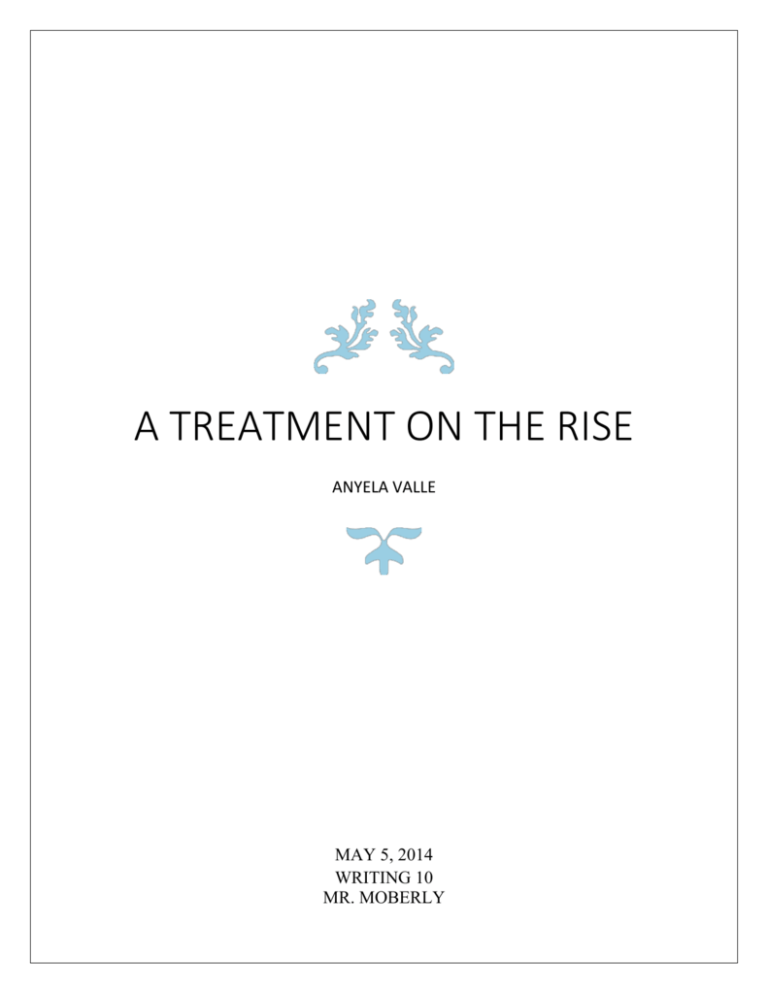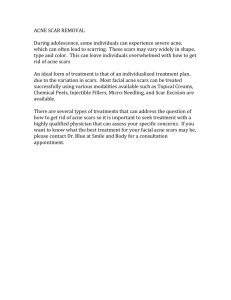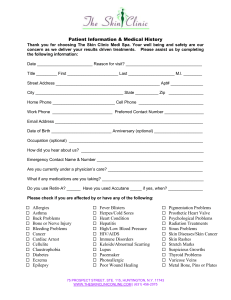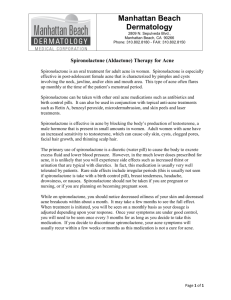File - Anyela Valle: Writing 10 Portfolio
advertisement

A TREATMENT ON THE RISE ANYELA VALLE MAY 5, 2014 WRITING 10 MR. MOBERLY Valle 1 Executive Summary Low self-esteem is one of many secondary effects caused by acne, a skin problem. Due to the secretion of sebum, an oily semi-fluid substance, from the sebaceous glands, the pores and hair follicles get plugged with sebum, dirt, and bacteria. From clogging of the pores, whiteheads or blackheads form just below the skin surface. As a result, acne has negatively marked the lives of many. It has acted as a barrier, preventing them from being confident individuals. Therefore, many acne treatments have been created to combat the growth of acne. However, these popular treatments, with unpleasant side effects, are not effective. For that reason, other forms of reducing bacteria in the stomach to prevent sudden breakouts have been proposed. For example, the consumption of healthy food could ultimately lead to the reduction of bacteria in the stomach, reducing the sudden erosions of acne in some people. Within this proposal, I explore, how through finding an alternative way of treating acne without the rigorous side effects, individuals can improve their way of living and fulfill their goals without being socially isolated. Background/ Problem Acne is a common skin disorder mostly affecting individuals between the ages 15 and 24. On his scholarly article from the Department of Medicine, R Marks informs that 80% to 90% of Americans suffer from this disorder (Marks 23). Acne affects different parts of the body, creating small lesions, ultimately leading to scarring if not treated. As a result, scientists have developed treatments to treat acne during the early stages before scarring begins. All the treatments that have been clinically tested have severe side effects; unfortunately nothing has been done to Valle 2 reduce these side effects. Authors Jasleen Kaur and Jyotika Kalsy, who frequently report on the Indian Dermatology journalist section, have reported on the results of acne treatments for safety and accurate results, however some of the side effects have been exclusively reserved from the public. The lives of many acne patients have been put at risk, due to the harmful side effects that have been kept undisclosed. Some of the side effects that are never mentioned in the most popular treatments include “skin cancer, scaling, dryness, burning, erythema, pain, nausea,” and many more (Kaur 96). When popular treatments are being advertised or recommended by others, the results of the treatments are guaranteed. However the side effects are mostly never mentioned which limits the individuals from deciding whether to go through the risky side effects or continue searching for alternative treatments. The fault is that most of the suggested treatments that promise effective results have severe side effects and ultimately do not improve the skin condition as promised. Most of the acne treatments’ side effects outweigh the benefits. Some patients find themselves experiencing various side effects, endangering their health. Not only are the side effects severe, but also the effectiveness of the treatments are very low. One of the first treatments that became widely known was Benzoyl peroxide, in the form of liquid, lotion, cream and gel, with the purpose of treating mild to moderate acne. Almost a century later, benzoyl peroxide is still being used as a treatment, however not as frequent as before. Its side effects such as “stinging, peeling of the skin, and possible burning” (Burkhart 92) has decreased its popularity. Another treatment with a harmful side effect is the Ultraviolet irradiation treatment that works by exposing the affected areas to high levels of UV exposure, equaling to sun exposure. According to previous sessions of UV exposure therapy, this method has been proven to age the skin and also increase the chance of causing skin cancer (Kaur 95). In addition, the Valle 3 oral antibiotic, Tetracycline, has also often been prescribed to patients as a way of treating acne. This pill is to be taken on an empty stomach, in order for it to reach its full effect. According to individuals who have taken this pill, they have experienced “sun sensitivity, tooth discoloration, nausea, gastric distress, and yeast infections” (“Acne”). The level of threat in these side effects are not to be taken slightly because they could have severe impacts on individuals’ health. At the Mayo Clinic information site, it has been said that tetracycline pills have been primarily prescribed to reduce bacteria from daily food consumption. Aside from breaking down the low levels of bacteria, tetracycline pills leave a big impact in the stomach from every dose taken (“Acne”). Since these are prescribed medication, the side effects should be clearly stated, however the importance of it seems to not be taken seriously. Other popular treatments such as Proactiv Solution, Neutrogena, and Clinique come in packets that contain up to 3 different creams or gels that require to be applied one after the other. The effects on the skin from these treatments are “redness, dryness, and itching, possible swelling of the tongue/ throat, and possible severe dizziness” (Kaur 97). Craig Burkhart, a pediatric dermatologist, once conducted a study of 6 months on acne patients, to test the effectiveness of Proactiv and another therapy. There was only 34% improvement in acne reduction with Proactiv Solution and a 39% using the other facial therapy. From Burkhart’s results, 34% was not a big improvement even after half a year of usage (Burkhart 91). Individuals whom have tried these products believe their levels of effectiveness are very low and unpredictable. Some testify that these products “never completely cleared [their] acne,” often just left uncomfortable side effects. Others agree that after stopping the treatments of Proactiv Solution, Neutrogena, and Clinique their acne “did get worse after four months.” Another acne patient “purchased the 3 step system Clinique and after 3 months of consistent use, saw no Valle 4 improvement in acne” (“Clinique…”). Most acne patients often abandon acne treatments prematurely because of its slow process and side effects. Although not all treatments have the same side effects, they still discourage patients to keep seeking for a solution to cure their acne. The Telegraph, a United Kingdom newspaper, recently reported the deaths of many acne patients linked to the “miracle drug,” Roacutane. This drug was used to treat severe acne with side effects that included “birth defects, miscarriage and mental problems” (“Controversial…”). One of the first cases found to be linked to this drug was that one of Jack Bowlby. He committed suicide in October 2012 after having ‘dark thoughts while on his medication’. Angela Lee was also a victim of the drug, who also committed suicide after leaving a note saying that she felt ‘prematurely aged’ and ‘there was no way out’. To test if these cases where somehow linked to the side effects of the drug, Doctor Sarah Bailey conducted a series of experiments on rats and the results came out to be positive. Indeed, the rats did acquire depression while on the drug (“Controversial…”). The life threating side effects were proven to be correct in these cases. These treatments are affecting the community in negative ways. Individuals are depriving themselves from a healthy lifestyle, all due to the ineffectiveness of some treatments. Not only do they lack results but also the side effects are causing additional problems. “Acne [is] scar[ing] not only the skin but also the psyche and even the soul” of individuals who suffer from this skin disorder (Marks 23). The number of individuals who suffer from acne have increased their levels of social withdraw, anxiety, and depression, after seeing that no treatment is working for them. The chances of improving the quality of life of a patient are decreasing. If acne treatments continue on having side effects as mentioned above, individuals will become discouraged in curing their acne condition and seek the easy way out. Valle 5 Proposed Solution The low effectiveness and severe side effects that come along popular acne treatments must be addressed. The usage of long-term antibiotics for the treatment makes the organisms develop resistance to the drugs. Therefore, we must “find ways to either mitigate these side effects or develop new, equally efficient anti-acne treatments with less severe side effects”(Hellman-Regen 292). I propose to develop an alternative way. A brand new natural product that fights acne is currently undergoing clinical trials to test its effectiveness. Rohollah Fouladi, a member of the Drug Applied Research Center, recently reported the rediscovery of an old forgotten natural herb. Berberis vulgaris (Barberry), a traditional herb, well known for its anti-inflammatory and antibacterial properties was first used in Indian folk medicine as an antiacne agent. Fouladi reported that the ingestion of oral extract of dried barberry, in the form of gelatin capsules, as of now is showing promising results. The herb is still in its developing stage, but so far no notable complications or side effects has been observed. The extract of dried barberry is considered to be safe, well-tolerated, and an effective choice to treat severe acne (Fouladi 254). This treatment, in the form of capsules, could only be obtained by prescription at any pharmaceutical location. In contrast, some people might argue that the gelatin capsules of barberry might not work for everybody. As a result, people may suggest to switch to other acne treatments such as oral antibiotics, creams, or even 3 step treatments such as Proactiv or Neutrogena. However, these alternative treatments all have severe side effects, which are not worth the little progress they have on acne. The barberry capsules are made of natural ingredients and their effectiveness has been proven in the little time it has been tested. If by any chance this treatment was not Valle 6 responsive or liked by patients it would leave no side effect. Unlike Proactiv Solution that after a few months of abandoning the treatment, acne comes back three times worse. As well as the oral antibiotics, that could permanently damage the stomach from the high levels of medication. Not only are these side effects unpleasant but also life threatening. As mentioned in the Saint Francis Care online website, “barberry does not only help strengthen the immune system but also benefits the cardiovascular and neural system. It also acts on the smooth muscles that line the intestines. This last effect may help improve digestion and reduce gastrointestinal pain” (“Overview…”). Aside from improving the skin condition, barberry offers extra benefits that other popular treatments have as side effects. Another alternative form of treating acne could be by balancing a healthy diet. Acne is an inflammatory disorder, so in order to reduce the inflammation, the diet could consist of artichokes, vegetables, herbs, salmon, and food with high antioxidants. Accordingly, tetracycline pills are specifically designed to kill bacteria which reduces the inflammation but the impact on the stomach was greater than the results. Therefore a healthy diet could in fact reduce the bacteria consumed and thus reduce the inflammation. Fast food, processed food, sugars, and dairy products should be eliminated from dietary meal plan because they have the lowest amount of vitamins and nutrients that the body needs to rebuild and regenerate. Ellen Marmur, a professor of dermatology, claims that having healthy skin is a matter of adopting good nutritional habits. Marmur believes that “if you give yourself five to 10 meals that provide a balanced diet, it will go a long way in preventing skin problems” (“Your…”). Consuming foods that contain Vitamins A and E, soothes the skin with no side effect. Maintaining a balanced diet does not only improve acne condition but also promote weight loss. This healthy diet does not include any side effect if implemented safely. Valle 7 Conclusion The lives of acne patients should not be put at risk, rather they should be improved. Although this alternative way of treating acne through the barberry capsule is not fully developed yet, it brings more benefits than any other popular treatment that has been introduced before. Barberry and a balanced diet show no side effects which is primarily the number one reason why they seem promising. By providing this alternative forms of anti-acne treatment, individuals can treat their skin while not having to go through rigorous side effects. It gives them an opportunity to have a healthy body and also cure their acne. Balancing a healthy diet can make a big difference not only to their skin but as well to their body. This method of treating acne does not require regular testing much less any expense. It could be incorporated in the daily life routine without having any hazardous side effects that could endanger the health of any individual. Individuals who suffer from acne have the option to change the side effects of popular treatments for benefits that come with these proposed treatments. These two alternative ways in no way endanger the lives of patients nor have side effects that could lead to death. Individuals now have the chance to choose between treatments, of course accordingly to their desires. Valle 8 Works Cited "Acne." Treatment at Mayo Clinic. N.p., n.d. Web. 21 Apr. 2014 "Clinique Acne Solutions Clear Skin System Reviews." On Acne.org. N.p., n.d. Web. 21 Apr. 2014. "Controversial Acne Drug Blamed for a Number of Suicides." The Telegraph. Telegraph Media Group, 04 July 2013. Web. 29 Apr. 2014. "Overview." Barberry. N.p., n.d. Web. 23 Apr. 2014. "Your Diet & Healthy Skin." WebMD. WebMD, n.d. Web. 29 Apr. 2014. Burkhart, Craig G., and Craig N. Burkhart. "Treatment Of Acne Vulgaris Without Antibiotics: Tertiary Amine–Benzoyl Peroxide Combination Vs. Benzoyl Peroxide Alone (Proactiv Solution™)." International Journal Of Dermatology 46.1 (2007): 89-93. Academic Search Complete. Web. 20 Apr. 2014. Fouladi, Rohollah F. "Aqueous Extract Of Dried Fruit Of Berberis Vulgaris L. In Acne Vulgaris, A Clinical Trial." Journal Of Dietary Supplements 9.4 (2012): 253-261. Academic Search Complete. Web. 20 Apr. 2014. Hellmann-Regen, Julian, et al. "Do Tetracyclines And Erythromycin Exert Anti-Acne Effects By Inhibition Of P450-Mediated Degradation Of Retinoic Acid?." Experimental Dermatology 23.4 (2014): 290-293. Academic Search Complete. Web. 20 Apr. 2014. Kaur, Jasleen, and Jyotika Kalsy. "Subcision Plus 50% Trichloroacetic Acid Chemical Reconstruction Of Skin Scars In The Management Of Atrophic Acne Scars: A CostEffective Therapy." Indian Dermatology Online Journal 5.1 (2014): 95-97. Academic Search Complete. Web. 2 Apr. 2014. Valle 9 Marks, R. "Acne -- Social Impact And Health Education." Journal Of The Royal Society Of Medicine (Supplement) 78.10 (1985): 21-24. Academic Search Complete. Web. 4 Mar




